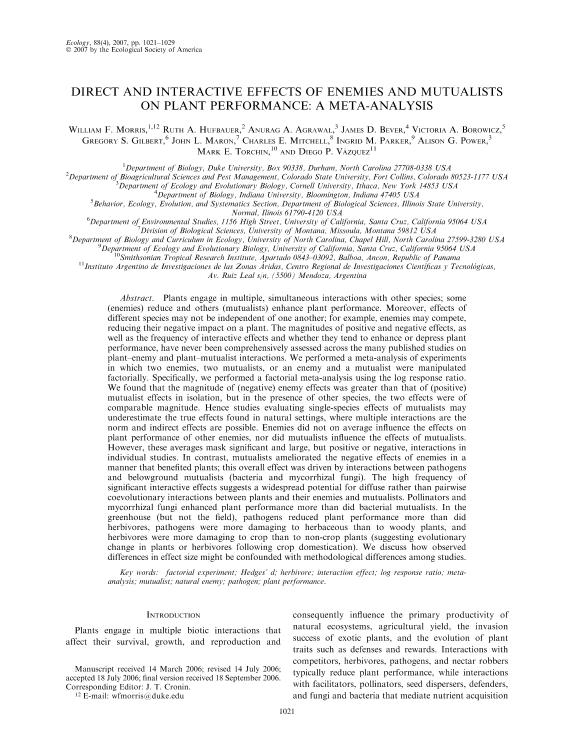Artículo
Direct and interactive effects of enemies and mutualists on plant performance: A meta-analysis
Morris, William F.; Hufbauer, Ruth A.; Agrawal, Anurag A.; Bever, James D.; Borowicz, Victoria A.; Gilbert, Gregory S.; Maron, John L.; Mitchell, Charles E.; Parker, Ingrid M.; Power, Alison G.; Torchin, Mark E.; Vazquez, Diego P.

Fecha de publicación:
04/2007
Editorial:
Ecological Society of America
Revista:
Ecology
ISSN:
0012-9658
Idioma:
Inglés
Tipo de recurso:
Artículo publicado
Clasificación temática:
Resumen
Plants engage in multiple, simultaneous interactions with other species; some (enemies) reduce and others (mutualists) enhance plant performance. Moreover, effects of different species may not be independent of one another; for example, enemies may compete, reducing their negative impact on a plant. The magnitudes of positive and negative effects, as well as the frequency of interactive effects and whether they tend to enhance or depress plant performance, have never been comprehensively assessed across the many published studies on plant-enemy and plant-mutualist interactions. We performed a meta-analysis of experiments in which two enemies, two mutualists, or an enemy and a mutualist were manipulated factorially. Specifically, we performed a factorial meta-analysis using the log response ratio. We found that the magnitude of (negative) enemy effects was greater than that of (positive) mutualist effects in isolation, but in the presence of other species, the two effects were of comparable magnitude. Hence studies evaluating single-species effects of mutualists may underestimate the true effects found in natural settings, where multiple interactions are the norm and indirect effects are possible. Enemies did not on average influence the effects on plant performance of other enemies, nor did mutualists influence the effects of mutualists. However, these averages mask significant and large, but positive or negative, interactions in individual studies. In contrast, mutualists ameliorated the negative effects of enemies in a manner that benefited plants; this overall effect was driven by interactions between pathogens and belowground mutualists (bacteria and mycorrhizal fungi). The high frequency of significant interactive effects suggests a widespread potential for diffuse rather than pairwise coevolutionary interactions between plants and their enemies and mutualists. Pollinators and mycorrhizal fungi enhanced plant performance more than did bacterial mutualists. In the greenhouse (but not the field), pathogens reduced plant performance more than did herbivores, pathogens were more damaging to herbaceous than to woody plants, and herbivores were more damaging to crop than to non-crop plants (suggesting evolutionary change in plants or herbivores following crop domestication). We discuss how observed differences in effect size might be confounded with methodological differences among studies.
Archivos asociados
Licencia
Identificadores
Colecciones
Articulos(IADIZA)
Articulos de INST. ARG DE INVEST. DE LAS ZONAS ARIDAS
Articulos de INST. ARG DE INVEST. DE LAS ZONAS ARIDAS
Citación
Morris, William F.; Hufbauer, Ruth A.; Agrawal, Anurag A.; Bever, James D.; Borowicz, Victoria A.; et al.; Direct and interactive effects of enemies and mutualists on plant performance: A meta-analysis; Ecological Society of America; Ecology; 88; 4; 4-2007; 1021-1029
Compartir
Altmétricas



